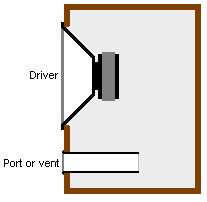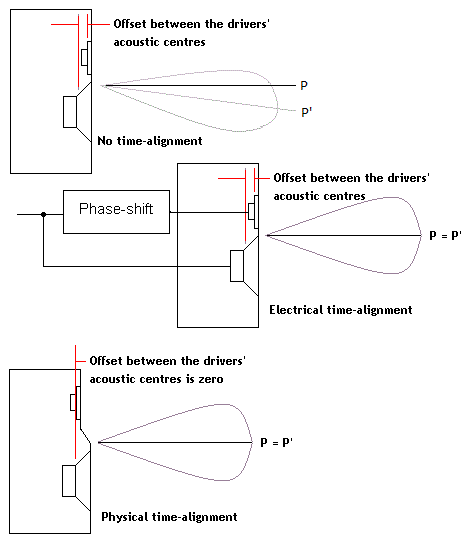The project is to build a set of Voigt Pipe speakers, and to see for myself if they are as awesome as they are supposed to be - as in audiophile level amazing. Fortunately the project isn't terribly expensive - it's mostly time and labor. Unfortunately, I don't have much time to perform the labor :)
NOTE: Links to updates
UPDATE 1: Panels are cut - Screw ups and hole cutters.
UPDATE 2: More screw ups, but the cabinets are assembled.
So what is a Voigt pipe? It's a unique speaker cabinet design that is intended to reduce/eliminate reflected sound waves from inside the cabinet. To better understand what's going on inside a speaker cabinet, let's discuss speaker cabinet design a little bit.
The first thing to understand is that a speaker - the actual driver - creates sound on both sides. Both the front and back of the driver emit sound, but the sound emitted at the rear is exactly opposite in phase as the sound coming from the front. In effect, you have an inward-facing speaker with the speaker wires attached to the wrong polarity.
The driver is optimized to project the sound from the front, but it still creates sound (with opposite phase) on the back side. Speaker cabinet designers have to decide how to deal with this sound coming from the back side of the driver. How designers deal with this out-of-phase sound largely determines the quality of the speaker.
Nearly all commercially available speakers use a ported bass-reflex design. Speakers of this design are simple and inexpensive to manufacture, are fairly compact, have well-understood audio qualities, and they have decent bass response. They are excellent all-around standard stereo speakers. That said, all ported bass-reflex speakers "color" the original sound, which is not what you want a speaker to do.
Below: A cutaway side-view of a ported bass-reflex cabinet.
By Image based on Bassreflex-Gehäuse_(enclosure).png created by
User:Melancholie., CC BY-SA 3.0,
https://en.wikipedia.org/w/index.php?curid=2745689
Porting: When the driver is reproducing low frequency sound, a lot of air is being pushed in and out of the cabinet. Porting accomplishes two things: It allows air to enter and exit the speaker enclosure, and it also provides an exit for the sound that is produced on the rear side of the driver.
Sometimes a passive radiator (a thin membrane) is used in place of the open port. Below: Speakers with a passive radiator design. The bottom circles are the passive radiator. This membrane replaces the port tube in the bass-reflex design, augmenting bass while eliminating resonances and whooshing sounds that can arise when using a port tube.
Ported bass-reflex cabinets reflect much of the rear-facing sound, and allow it to exit the cabinet from a front-facing port, increasing efficiency. This reflection technique creates some problems with faithful sound reproduction, however.
One issue with the ported bass-reflex design is that - depending on the frequency of the sound - the reflected sound wave may be in-phase or out of phase with the driver cone. The reflected sound waves cause interference with the driver. At a given frequency, reflected from inside the speaker enclosure may be in or out of phase with the driver - and augmenting or diminishing the volume depending on the pitch of the sound. This is called "frequency combing", and equalizers are often used to attempt to compensate for it, with mixed success.
"Frequency Combing" becomes noticeable when reflected waves are in-phase with the driver vibration, causing a certain frequency to become noticeably louder. When the reflected waves are out of phase with the driver, they cause a certain amount of noise cancellation to occur. Ideally, a speaker should have a very flat frequency response all the way through the audible range.
Below: A speaker frequency response curve displaying frequency combing vs one that is reasonably flat and clean.
Ported bass-reflex speakers are packed with damping material - typically
fiberglass - in an attempt to reduce and broaden out the energy of the reflected sound
waves that return back to the driver. This helps to flatten the response curve by reducing reflected interference with the driver. However it's not possible to dampen lower
frequency bass notes with fiberglass. And so bass reproduction is another reason these
speakers don't compare well with some other designs.
Poor bass sound reproduction is especially noticeable in percussion. Ported bass-reflex speakers tend to boom like distant thunder, instead having a sharp crack like the sound made by a nearby lightning strike. The design doesn't reproduce dynamic sounds like percussion well, and so the bass, while loud, is muddied rather than crisp. However, these speakers do produce a lot of bass, and for a reasonable price. Ported subwoofer enclosures are popular in cars, and while they can vibrate everything within a city block, they aren't punchy or crisp sounding at all. This could be considered a case of sound quantity over quality.
One technique speaker designers have of getting around the rear-side phasing problem is the 'transmission line' speaker enclosure. Briefly, rather than reflecting sound back toward the driver and causing interference, they instead route the sound through a long tube away from the driver, and out of the enclosure. Since a long tube is awkward to build, speaker designers usually make a geometrically complicated labyrinth inside a standard-looking cabinet.
Below: A simplified transmission line speaker cabinet.
By Stephane Tsacas - own work. Inpired by
http://imf-electronics.com/Studio/index.html . NB I'm the webmaster of
imf-electronics.com ..., CC BY-SA 4.0,
https://commons.wikimedia.org/w/index.php?curid=6701908
With the transmission line arrangement, you get very little reflected sound, amazing sound reproduction, and excellent bass efficiency. However... these enclosures are complex. They are expensive, difficult to build properly, and difficult to tune so as to avoid resonances.
Below, a wood-worker builds a transmission-line speaker enclosure. Pioneer and Sony don't bother with this sort of thing - only a boutique audio company would go to this level of effort and engineering.
Bose built a tabletop radio that managed to sound amazing compared to the competition. Are you curious what it looked like inside? Looks like a transmission line to me. This is obviously a plastic and inexpensive to manufacture cabinet, but it still sounds much better than a standard speaker enclosure.
The last type of speaker design is the horn speaker, which I suppose everyone understands, although the principles are not widely understood by people who don't design speakers.
Below: A horn-type speaker.
By Chetvorno - Own work, CC0, https://commons.wikimedia.org/w/index.php?curid=20380275
The horn design takes a small speaker movement, and provides a continuously expanding throat for the compression waves to travel out. This matches the impedance of the driver to the impedance of the surrounding air, allowing amplification to occur. The horn converts a small displacement, high pressure wave to a large displacement, low pressure wave - a form of mechanical amplification.
One final issue that a speaker cabinet can have is "timing". This is only a problem with speakers that have more than one driver in the cabinet (i.e. a woofer, mid-range, and/or tweeter speaker). The diaphragms of each driver are not usually the same distance from the listener in standard speaker cabinets, and this results in high, mid and low frequencies arriving at the listener's ear at slightly different times. This is not desirable in high fidelity sound reproduction, because speakers are not supposed to distort what should be the faithful reproduction of a live performance.
Speakers can be time-aligned, either by offsetting the speakers forward or backward physically so that their diaphragms are in exactly the same plane, or by incorporating a delay circuit that ensures each speaker's sound arrives at the listener at the same time.
Below: Time-alignment of a two-driver speaker cabinet, courtesy of CC BY 3.0, https://en.wikipedia.org/w/index.php?curid=33983685
And now, armed with a better understanding of some speaker design issues, we can get back to our Voigt pipe speaker cabinets:
This design uses all three techniques (porting, transmission line, and horn) to achieve excellent bass response and efficiency, transmission line quality sound reproduction, and horn type amplification. The reason very few Voigt pipes are manufactured is that they have to be very tall, and they look odd.
Below: Voigt pipe speakers
The purpose of this unusual-looking cabinet is to almost perfectly prevent internally-reflected sound from bouncing back to interfere with the driver. The port at the bottom acts as a horn to allow rear-side sound to leave the enclosure with horn amplification. The top acts as a compression chamber, behaving as a tapered transmission line. This taper is also filled with fiberglass to further dampen reflected sound inside the cabinet from interfering with the driver.
Part of the beauty of this design though, is simplicity and cost of construction, especially compared with a standard transmission line speaker cabinet. They don't suffer from timing issues, because there is only one driver. Having only one driver also eliminates the need for an audio crossover. The audio crossover can cause drop-out of certain frequencies when it splits the signal between two or more speakers.
The Voigt pipe design is also called a Tapered Quarter-Wave Pipe (TQWP), and I'm currently in the process of building a pair.
Before beginning, it's important to start with project grease - Monster Energy and Music.
Below: The cabinet portion of this project requires two 4ft x 8ft sheets of plywood. I picked 3/4" red oak for the project - not so much due to the audio qualities, but because I like the appearance of it. Yes, that's a mid-1990's Pioneer ported bass-reflex speaker upstairs, hopefully to soon be replaced with a Voigt pipe. Next to it is a vintage Italian steel Masi bicycle from the late '80's. I need to get off my butt and start riding the bike again.
 |
Below: The line I need to cut. This cut requires a really long straight edge, and a steady hand with a radial saw - and some free time. The free time part of these projects is always tough when it isn't winter. This project and post will be updated as the parts arrive and I have time to make progress. EDIT: Updates are now linked at the bottom of this post.
UPDATE 1: Panels are cut - Screw ups and hole cutters.
UPDATE 2: More screw ups, but the cabinets are assembled.
Below, the YouTube video that got me interested in this project. He goes in into a very deep explanation of the things I addressed above, and can be a bit difficult to follow, but I stuck with it. I blame/thank Tech Ingredients for getting me interested and moving forward with this.















4 comments:
I hope to be able to listen to the speakers, and at various volume levels and different types of music.
Same! I really want to see if they are as great as all that - which is kind of the point of building them.
Will be following this project. Is the length of the speaker cabinet relative to the size of the speaker driver itself?
Yes Eric, it seems to be. I've seen two different sets of plans - one for a 6" driver and one for an 8" driver. The cabinet for the 8" is about 18 inches taller. I'm not a speaker designer, but I assume that the cabinets have dimension ratios that must be kept the same. Below is a link showing the dimensions of the ones I'm building
https://drive.google.com/file/d/1OVjDQaTqrq7KNBUptcnbwGnzjOXB_LF-/view
Post a Comment